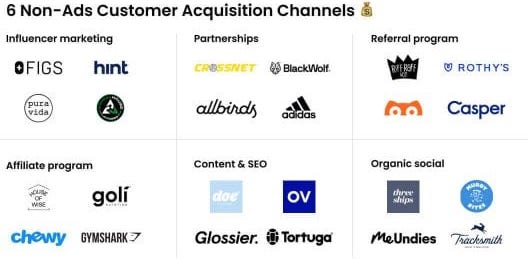Diversifying your customer acquisition channels is a growing concern among ecommerce retailers. With the growing cost of traditional online advertising and pay-per-click advertising, costs have risen so much that brands are looking for other ways to tap into new audiences.
And with the rollout of iOS14, ad tracking and performance have gotten even worse for most. Despite that, you probably should not stop your ads altogether—especially if ads have been your main customer acquisition channel.
But it might be worth diversifying your channels to lower your cost. And that’s what this article is about. Let’s walk through six other channels and how you can get started.

1. Influencer marketing
Over the years, brands have shifted away from sponsoring only celebrities and influencers with huge social media followings to micro and nano-influencers, who have smaller but more engaged followings.
FIGS’ brand ambassador program
Scrub brand FIGS has hundreds of doctors, nurses, and other professionals in the healthcare sector as its brand ambassadors. In exchange for receiving free scrubs and invitations to events, these ambassadors post about the brand on Instagram and TikTok.
There are more than 90,000 Instagram posts with “#wearfigs”. And TikTok videos with “#wearfigs” have generated more than 288 million views.
And it is paying off. According to Modern Retail, “These promotional efforts have helped to shape some of the company’s most impressive business metrics. Figs’ customer acquisition cost tumbled 61% between 2018 and 2020 to $39, according to its S-1.”
For more examples, you could research Hint Water, Pura Vida Bracelets, and MonkeyFeet.
How to get started with influencer marketing
There is no one right way to “do” influencer marketing.
FIGS has a form for interested medical professionals to apply to be an ambassadors. On the other hand, some brands rely on platforms like #Paid, influence, TRIBE, and minisocial to find influencers to work with. Some brands offer gifts while others give cash upfront.
When you are just starting, you could reach out to your top customers (or top referrers) to ask whether they would be interested in working with you. It’s best to understand what they would want in exchange (and it isn’t always money).
To learn more, we would recommend Cody Wittick’s ecommerce influencer marketing guide. Wittick is the Managing Partner at influencer marketing agency Kynship, which has helped many brands with their influencer marketing.
2. Consider partnerships as a customer acquisition channel
While not the easiest to get started with, partnerships are a good way to reach and acquire customers who have not heard of your brand. Partnerships can also help you create a unique product that customers would want, grow your social media following, improve your branding by associating with similar brands, and more.
How to get started with partnerships
Partnerships work best when the partnering brands…
- have similar branding
- are targeting similar audiences
- have products people use together (but not competing)
In the example above, both CROSSNET and Black Wolf have personal and humorous branding. They both target people who like to be outdoors. And people who are outdoors likely care about their skin.
Can you think of brands that match these criteria for your brand?
If not, a simple way to get started is to go to your Instagram profile and click on the tiny dropdown arrow. Instagram will suggest similar accounts for you to check out. Another option is to survey your customers about other products that they buy.
If you are feeling a little more advanced, you could check out tools like co-op to help find partners and Quantcast Measure to understand your customers better.
3. A referral program should be in the mix
A referral program is unlikely to replace your ads entirely but the cost of getting a customer through a referral program is much lower than through ads. For example, A Box of Stories adopted a referral program to lower their customer acquisition cost.
Riff Raff & Co is one of our favourite examples because a referral program fits its business model perfectly.
It sells sleep toys for babies and toddlers to mothers. Being a mother, founder Emma Kruger knew that mothers usually hang out together and chat about their experiences. And mothers trust other mothers more than anyone or anything else.
When a new customer purchases a sleep toy through a referral, she gets free shipping. On the other hand, anyone who refers to five new customers gets a free sleep toy (worth $65). Almost one in every four Riff Raff & Co customers bought its product through a referral.
How to get started with a referral program
We have seen referrals work for a wide range of products. But it works exceptionally well for the following categories of products:
- personal products (e.g. underwear) because consumers would rather trust a friend than an ad
- products that people are cautious about buying without knowing it works (e.g. health supplements, skincare) because again consumers would rather trust a friend than an ad about the product
- products that are bought repeatedly (e.g. toiletries) because customers would want to earn a discount for their future purchases
You will see more success with your referral program if you already have a baseline of monthly orders (~100) and you know your customers are telling others about your brand.
4. Affiliate program
An affiliate program is best when your customers love your products and want to make money from recommending them. Affiliates are usually paid a percentage of the sales generated, so you are only paying for any results you get.
House of Wise is a CBD brand that wants to help women improve important areas of their lives such as sleep, sex, stress, and finances.
Founder Amanda Goetz explained on Banknotes why she picked the affiliate model (and why it works for them):
“It was a way to build trust and confidence in our products. The cannabis market can be confusing, and we knew it would be important for women to hear about our products from people who had used them and achieved the desired results in the form of more sleep, better sex, and less stress.”
We recommend reading the full article if you are interested in trying an affiliate program.
For more affiliate program examples, check out Goli Nutrition, Chewy, MiaoMiao, and Gymshark.
How to get started with an affiliate program
Some products are more suited for an affiliate program than others. Two good questions to start with are:
Do people want to hear from a trusted friend before trying my products? Some products are impulse purchases. People would buy them simply after seeing an ad. But some products require a bit more convincing, which an affiliate can help with.
Would my customers want to make money from recommending my products to others? Some demographics, such as bloggers or content creators, are more interested in this than others. And they tend to be in areas like fitness, travel, and health.
If you want to get started with an affiliate program, Hubspot offers these articles on the top 50 affiliate Marketing programs.
5. Content marketing and SEO
Having done content marketing and SEO at Buffer and ReferralCandy (millions of monthly pageviews altogether), we know they help lower customer acquisition costs—not just for SaaS companies but ecommerce brands.
SEO agency founder Jason Wong grew Doe Lashes’ monthly organic traffic from 1,800 to 27,000. And it ranks for many highly relevant keywords like “lashes”.
Here are some of the things they did:
- Created AMP pages for the website, which load super fast
- Rewrote headers on every page with important keywords
- Wrote many articles answering questions that people search around their product (e.g. will false lashes ruin my real eyelashes)
A few other brands that have been good with content marketing are Outdoor Voice, Tortuga Backpacks, and Glossier.
How to get started with content marketing and SEO
As Wong said in his Twitter thread, “SEO is a long game, but it’s something that compounds over time, so the earlier you start, the better.” This matches my experiences at Buffer and ReferralCandy. Both companies took years to build up consistent, high-volume organic traffic.
While ads tend to give you immediate results, organic traffic should eventually contribute the most to your customer acquisition because it is more sustainable and cost-effective. A good approach is to use ads to get early results while building up your SEO since it takes time.
My favourite place to learn about content marketing, SEO, and getting organic traffic is the Ahrefs blog. The team has also created a comprehensive guide for ecommerce SEO.
6. Organic social media
Organic social media is another long game. We will tell you straight-up that it will be almost impossible to track sales from social media. But that’s not the point. Just because you can’t measure it doesn’t mean it is not valuable. As cliche as it might sound, social media improves your branding and improves the performance of all other channels.
Take a look at MeUndies’ Instagram account.
The team regularly create new underwear prints and shares hints and heads-ups on their Instagram account.
Their customers, on the other hand, are constantly asking when new prints will be released so that they can buy more MeUndies as soon as the new prints are available.
The team wouldn’t know if someone sees one of their Instagram posts, goes to their online store, and buy a pair. But we’re confident people who have seen and interacted with their Instagram posts are more likely to buy when they see MeUndies’ ads or emails.
For more examples of brands with great social media, check out Three Ships, Muddy Bites, and Tracksmith.
How to get started with organic social media
Getting started on social media is easy but doing well is hard. Randomly posting on social media isn’t a strategy (but it might take some testing to figure out what your audience likes).
The best thing to do is to follow a ton of brands on Instagram (or your preferred platform), see what they are doing and what is trending on the platforms, and test lots of content. In general, people want to be entertained or educated, so you could experiment with those types of content first.
The Later blog is a great place to learn more about social media strategies, trends, and tricks.
What are we missing?
There are other customer acquisition channels that we did not mention. For example, there is a whole other category of offline channels, such as in-person events, popup stores, retail expansion, and more.
What is working well for you? What should other marketers try?
Let us know in the comments below!





